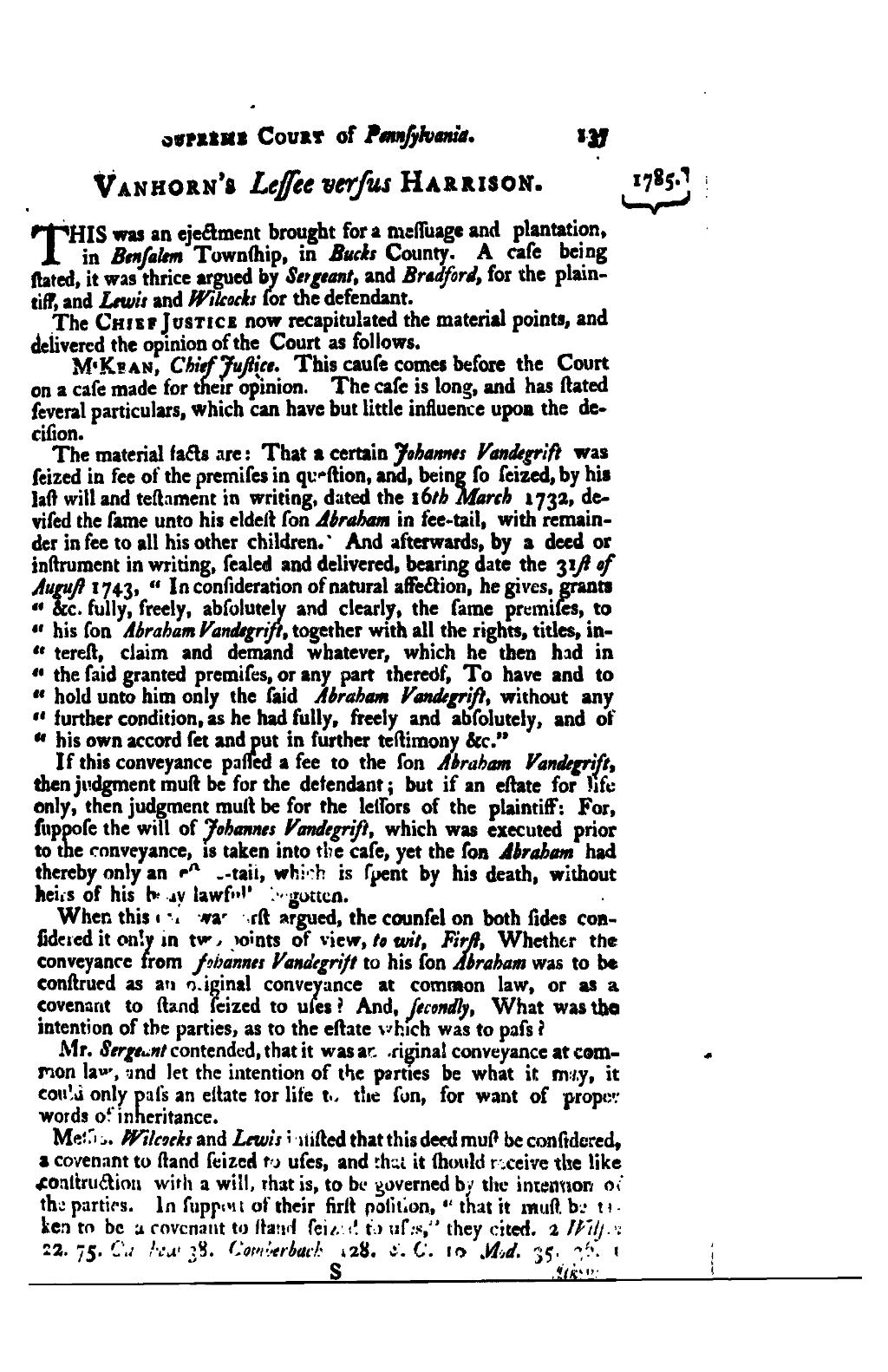1785.![]()
Vanhorn’s Leſſee verſus Harrison.
T
his was an ejectment brought for a meſſuage and plantation, in Benſalem Townſhip, in Bucks County. A caſe being ſtated, it was thrice argued by Sergeant, and Bradford, for the plaintiff, and Lewis and Wilcocks for the defendant.
The Chief Justice now recapitulated the material points, and delivered the opinion of the Court as follows.
M‘Kean, Chief Juſtice. This cauſe comes before the Court on a caſe made for their opinion. The caſe is long, and has ſtated ſeveral particulars, which can have but little influence upon the deciſion.
The material facts are: That a certain Johannes Vandergrift was ſeized in fee of the premiſes in queſtion, and, being ſo ſeized, by his laſt will and teſtament in writing, dated the 16th March 1732, deviſed the ſame unto his eldeſt ſon Abraham in fee-tail, with remainder in fee to all his other children. And afterwards, by a deed or inſtrument in writing, ſealed and delivered, bearing date the 31st of Auguſt 1743, “In conſideration of natural affection, he gives, grants &c. fully, freely, abſolutely and clearly, the ſame premiſes, to his ſon Abraham Vandegrift, together with all the rights, titles, intereſt, claim and demand whatever, which he then had in the ſaid granted premiſes, or any part thereof, To have and to hold unto him only the ſaid Abraham Vandergift, without any further condition, as he had fully, freely and abſolutely, and of his own accord ſet and put in further teſtimony &c.”
If this conveyance paſſed a fee to the ſon Abraham Vandergrift, then judgment muſt be for the defendant; but if an eſtate for life only, then judgment muſt be for the leſſors of the plaintiff: For, ſuppoſe the will of Johannes Vandergrift, which was executed prior to the conveyance, is taken into the caſe, yet the ſon Abraham had thereby only an eſtate-tail, which is ſpent by his death, without heirs of his body lawfully begotten.
When this caſe was firſt argued, the counſel on both ſides conſidered it only in two points of view, to wit, Firſt, Whether the conveyance from Johannes Vandergrift to his ſon Abraham was to be conſtrued as an original conveyance at common law, or as a covenant to ſtand ſeized to uſes? And, ſecondly, What was the intention of the parties, as to the eſtate which was to paſs?
Mr. Sergeant contended, that it was an original conveyance at common law, and let the intention of the parties be what it may, it could only paſs an eſtate for life to the ſon, for want of proper words of inheritance.
Meſſrs. Wilcocks and Lewis inſiſted that this deed muſt be conſidered, a covenant to ſtand ſeized to uſes, and that it ſhould receive the like conſtruction with a will, that is, to be governed by the intention of the parties. In ſupport of their firſt poſition, “that it muſt be taken to be a covenant to ſtand ſeized to uſes,” they cited. 2 Wilson 22. 75. Carthew 38. Comberbach 128. S. C. 10. Mod. 35. 36. 1
Atykns
